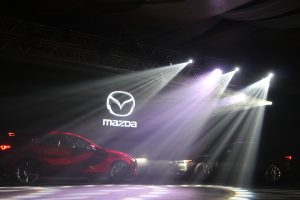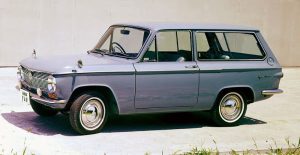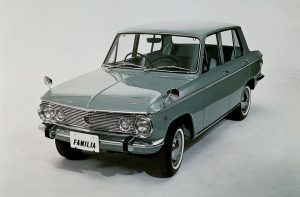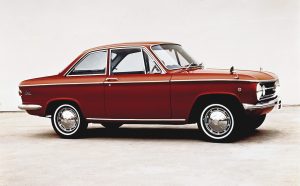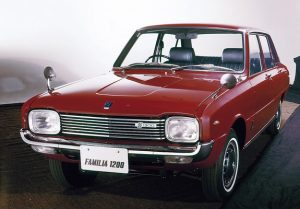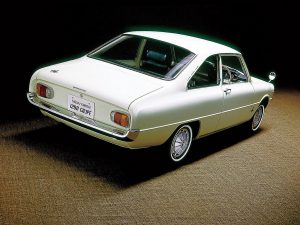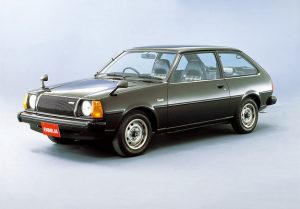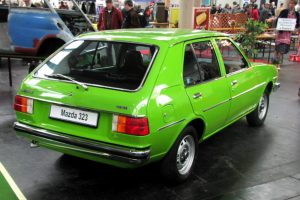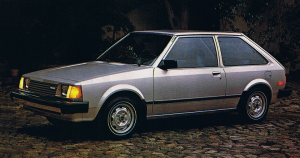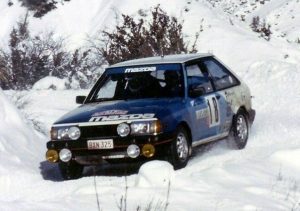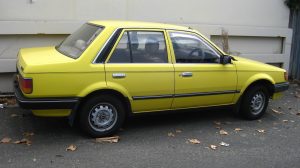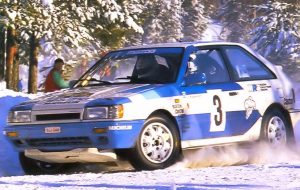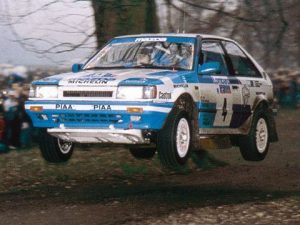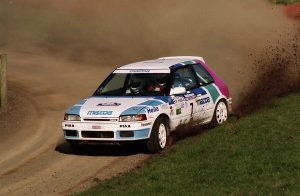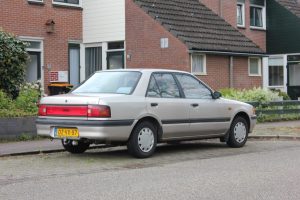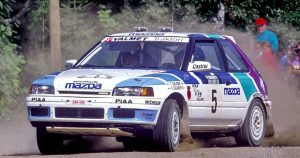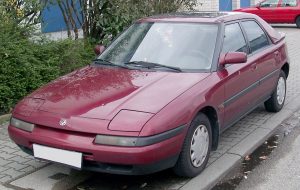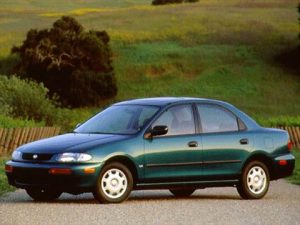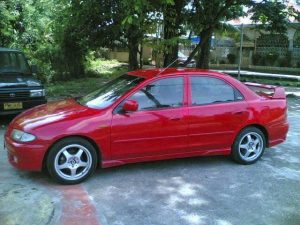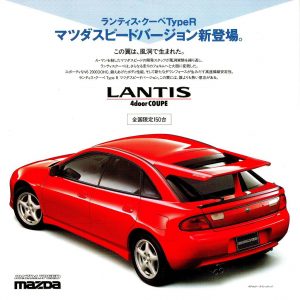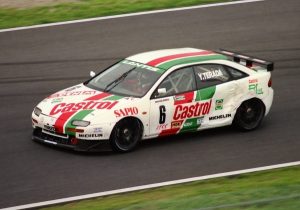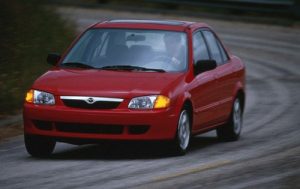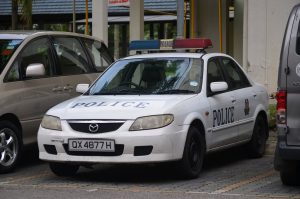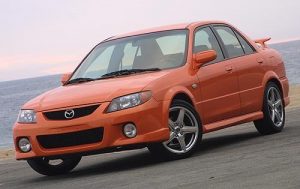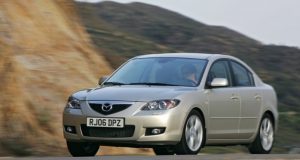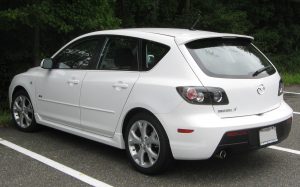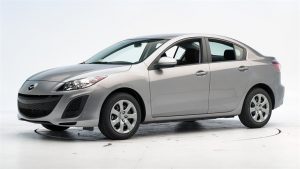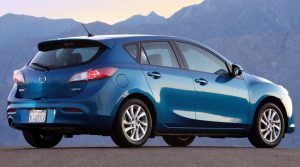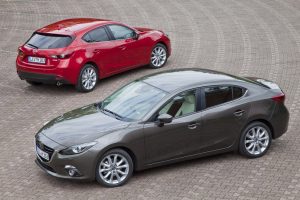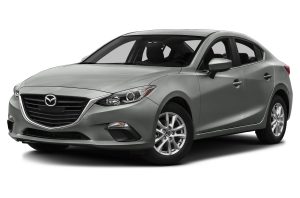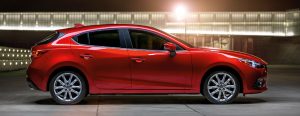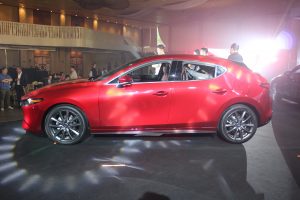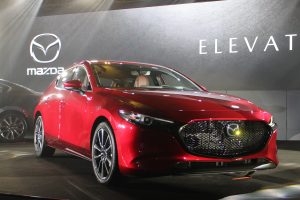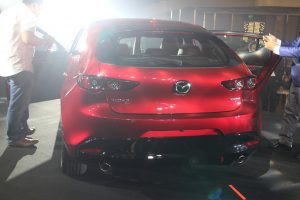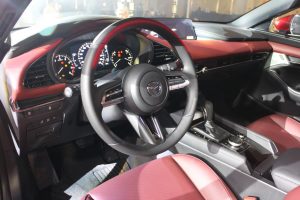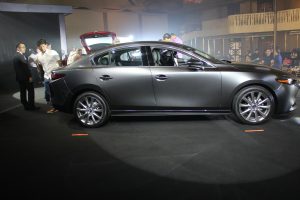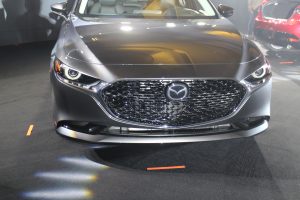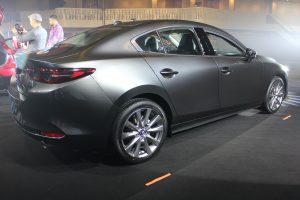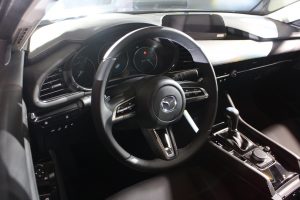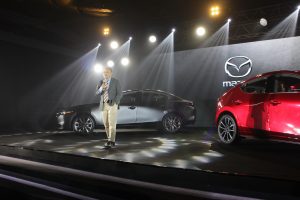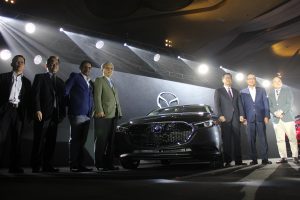While viewing the latest generation of the Mazda3 during a recent sneak preview held by Berjaya Auto, the Philippine distributor of Mazda Automobiles, we were given a short but fascinating history of the model. From when it was marketed as the “Mazda Familia” to its model name change to “323” to its current model designation, the Mazda3 has a long and storied background. Here’s a short trip down memory lane of how the Mazda3 came to be.
1963-1967 Mazda Familia 800-1000
In the early sixties, Mazda was planning to introduce larger cars as the Japanese economy was improving and the customers were demanding more space and prestige than the kei or small cars that the company was offering. The Mazda 700 prototype was shown at the 1961 Tokyo Motor Show and the first production Familia, which was styled by a young Giorgetto Giugiaro who was then working at Carrozzeria Bertone, appeared in October 1963. In line with Mazda’s policy of only gradually approaching the production of private cars (a luxury in Japan at the time), the first Familia was initially only available as a commercial two-door wagon called the Familia Van. The van was joined in April 1964 by a plusher Familia Wagon, in October by a four-door sedan, in time for the 1964 Summer Olympics, and in November by a two-door sedan. The “flat deck” design of the sedan versions was reportedly inspired by the Chevrolet Corvair. Private car versions received fog lights in the grille as well as more chrome trim. The Familia used a 782 cc, “SA” four-stroke aluminum inline-four engine and was sold in other markets as the 800.
A new Familia 1000 Coupé arrived in November 1965 with a 985cc SOHC “PC” engine while the 800 engine was upgraded, adding three horsepower. As a number of new 1,000cc vehicles were introduced by Mazda’s competitors, another 987cc OHV engine (PB) appeared in January 1967, powering new 1000 sedan and van versions. The 1.0-liter sedans and vans are recognizable by their broader, rounded-off rectangular headlights. Production of the sedan continued until November 1967, while the van versions continued until they were replaced in February 1968. Around 400,000 of the first Familias were built, 130,473 of which were sedans and coupés.
1967-1973 Mazda Familia 1000-1200
The new Mazda Familia appeared in November 1967 with the same pushrod 987 cc engine as used in the previous generation sedans. It was sold as the Mazda 1000 in some markets. After an April 1970 facelift, the slightly different OHC “PC” engine was also offered, in a model called the Familia Presto in the domestic Japanese market. A larger 1169 cc inline-four engine came in February of the following year, becoming the Mazda 1200 for export. In this form, the car was first exhibited in Europe at the 1968 Paris Motor Show in the autumn of that year. Power outputs (SAE gross) in Japan of the facelifted, overhead-cam-equipped versions were 62 and 75 PS (46 and 55 kW) respectively. The Familia Van (wagon) model was available with either three or five doors, although most export markets only received the five-door version.
From model year 1970 on the Familia was also available with the new overhead camshaft 1.3-liter TC engine, derived from the smaller 1.0-liter OHC engine already seen in the first generation Familia coupé. 1970 also saw a larger sedan which shared much of its mechanical parts with the Mazda Capella. The Familia was exported as the Mazda 1300 and replaced the previous generation 1200 model in most markets. The sedan and coupé were updated in the autumn of 1973, but the truck and wagon/van versions continued with little change.
1977-1980 Mazda Familia/323 (AP-series)
The Mazda Familia AP-series debuted in January 1977 and was branded as the 323 in most of the world or GLC for “Great Little Car” in North America. It was a rear-wheel-drive subcompact, preceding Familia 1000/1300. There was a choice of hatchbacks and station wagon bodies, both available with a three- or five-door body styles. The station wagon version was a bit later, first being introduced in June 1978, which also meant that the commercial versions based on the 1970 Familia could finally be retired. Three Mazda engines were available, the 985 cc PC, 1,272 cc TC, and the 1,415 cc UC (introduced in March 1978). The 1.0-liter unit was only made for export markets. The new Familia AP marked the first appearance of the 323 name.
In June 1979, the Familia/323 underwent a facelift, replacing the previous round headlights with rectangular units which were designed as a single unit along with the grille. The new style was in line with that of the Mazda Capella/626 (CB).
1981- 1984 Mazda Familia/323/GLC (BD-series)
First shown on June 2, 1980, the Mazda Familia/323/GLC BD-series was entirely new – it was Mazda’s first front-engine, front-wheel drive subcompact car, and was available as a hatchback and sedan. It was developed with input from Ford, which in 1979 had acquired a stake in the Japanese manufacturer, and had a twin called the Ford Laser, which was marketed here in the Philippines. At its introduction in 1980, it won the first Car of the Year Japan Award and Wheels Magazine Car of the Year 1980.
The most powerful version was marketed as the 323 GT in European markets while in North America, it was known as the Mazda GLC. The Familia/323/GLC was a strong comeback for Mazda in the Japanese market, even outselling the Toyota Corolla on several occasions. It underwent a facelift in January 1983.
1985- 1989 Mazda Familia/323/GLC (BF-series)
In January 1985, the fifth generation BF-series Familia/323 featured many updates. It was available as a hatchback or sedan only for the first year, and wagon and cabriolet models were added in November 1985 and March 1986 respectively. In January 1987 a personal coupé version with its own bodywork, the Étude, was added. In February 1987 the Familia range underwent a light facelift that included replacing the old E engines with the more modern B series. In some markets, such as Indonesia, the B engine continued to be installed after the facelift.
This generation of the Familia/323 was also available in a version with a turbocharged DOHC engine, with either front- or four-wheel drive, producing 140 PS (103 kW). The 4WD version was introduced in October 1985, was sold in either a light-weight GT or fully optioned GT-X grade, and saw some success in rally’s Group A category. A limited production Japanese-only homologation special, the 4WD GT-Ae, appeared May 1988 and offered an additional ten horsepower and viscous rear limited slip differential.
1990-1994 Mazda Familia/323/Astina (BG-series)
The sixth generation Familia BG-series included three-door hatchback, five-door fastback, and a four-door sedan variants, none of which share any body panels. The new five-door fastback version was called the Familia Astina in Japan and was sold as the 323F or 323 Astina elsewhere. The BG Familia was available with front- or all-wheel drive and a 1.3 L, 1.5 L, 1.6 L, or 1.8 L gas or 1.7 L diesel engine.
Later, a turbocharged engine was added, especially developed for homologation purposes for the World Rally Championship, Group A category. The four-wheel drive models (including the turbocharged GT-X) were introduced in August 1989. In Japan, the SOHC 1.6 was only available coupled to four-wheel drive. With a carburetor, it offered 91 PS (67 kW), the same as the lower-spec 1.5, but with a somewhat larger torque curve. In Europe, only the 1.8 (in naturally aspirated, 106 PS form or either of the turbocharged variants) was offered with four-wheel-drive.
1994-1998 Mazda Familia/323/Protege (BH-series)
The BH-series model was released for the Japanese domestic market in 1994 with front-wheel drive. Production of this generation started in August 1994 and ended in June 1998. The sedan version was sold as the Protegé in North America, as the Mazda Artis in some South American markets, as the Mazda Étude in South Africa. The BH Familia grew considerably, with the four-door sedan’s wheelbase only a few millimeters short of the then-current Toyota Camry. The car was not originally offered with a 1.3-liter engine in Japan, with the lineup beginning with the bigger 1.5. To close this gap in the lineup, the BG hatchback with the 1.3 was kept in production until October 1996, when the new hatchback model was introduced (323P) and the smaller engine was made available.
The rare North American ES model came with the Miata’s 1.8-liter twin-cam engine (though the internals were not entirely the same), all-wheel disc brakes, and dual stabilizer bars. The same car went on sale in Australia in the second half of 1994 with a fully featured BP-ZE engine. The Protegé became classified as a “compact car” for the 1995 model year in North America. A MazdaSpeed version was released in Japan and Philippines. It came equipped with MazdaSpeed wrap around bodykit, MazdaSpeed rear spoiler, Momo steering wheel, 15-inch Rota Astral wheels wrapped in 195/55R15 Bridgestone Potenza RE01 tires, MazdaSpeed strut tower bar, Eibach springs, gas-charged shock absorbers, swaybars and MazdaSpeed exhaust made by Yumex. A five-door hatchback featuring pillarless doors and distinct sheetmetal from other 323s was sold in Japan and the Philippines as the Mazda Lantis. The Familia/Protegé/323 was facelifted in 1996, with a newer somewhat more aggressive style.
1998-2003 Mazda Familia/323/Protege (BJ-series)
A redesigned eighth generation BJ-series Familia was introduced in June 1998 and released in September as a 1999 model. Body styles included a four-door sedan, five-door S-Wagon (sold as the Protegé5 in the United States and Canada, and Astina NU in some Asian countries) and a three-door hatchback. A 4EC automatic transmission and two five-speed manual transmissions were available while all-wheel drive is optional. The 1999 BJ platform was updated with a four-door sedan or five-door hatchback chassis based on the larger Mazda Capella and offered with more engine choices.
Mazda 323s were used as police cars by some police departments such as the Singapore Police Force under Fast Response Car (FRCs). In 2001, the entire line was facelifted with new styling, a revised suspension, and a new audio system. In 1999, Ford of Japan ceased to market Mazda-based models, and the Ford Laser, along with the Ixion, Telstar and Festiva, was discontinued. In 2003, Mazdaspeed introduced the Mazdaspeed Protegé, an update to the Protegé MP3 that had a 170 hp (127 kW; 172 PS) / 160 lb?ft (217 N?m) turbocharged engine, shared the MP3’s full Racing Beat suspension, redesigned 17-inch (430 mm) wheels, larger four-wheel disc brakes, and a Kenwood stereo system that included an amplifier along with a rear-deck mounted 8-inch (200 mm) sub.
2004-2009 Mazda3 (BK-series)
The entire Mazda Familia model line was replaced by the Mazda3 in October 2003 and introduced as a 2004 model. The BK-series Mazda3, which was sold as the “Axela” in Japan, came in four-door sedan and five-door hatchback varieties, with a 2.0-liter engine. It shared its platform with the Volvo S40 and the second generation Ford Focus. The model has been generally well received by the automotive press for its performance, handling, styling and interior, with some describing it as feeling like a more expensive sports sedan/saloon despite its value-oriented price. In 2006, the Mazda3 was the second best-selling car in Canada and the best selling car in Israel during 2005–2007.
The front suspension comprises MacPherson struts, with coil springs and an anti-roll bar. The rear suspension is a Ford-designed “E-link” multi-link suspension, with four locating links per wheel and an anti-roll bar, suspended on coil springs that are mounted inboard of the shock absorbers to reduce suspension intrusion into the cargo area. Four-wheel Disc brakes are fitted, with 300 mm (11.8 in) discs in the front and 279 mm (11 in) discs in the rear; ABS and electronic brake force distribution are available or standard, depending on the model. Wheel and tire sizes vary with model, from 15″ on base models to optional 17″ wheels on upper-level models.
2009-2013 Mazda3 (BL-series)
In development from 2004 and designed under Kunihiko Kurisu from early 2005 to August 2006, Mazda debuted the second generation Mazda3 in November 2008 with a restyled exterior. The C1 architecture, a collaboration of Ford, Mazda, and Volvo, was carried over from the previous generation. The new Mazda3 was marginally wider, longer and lighter than the previous car. The 2.3L engine was replaced with a 2.5L engine that produces 167 bhp (125 kW; 169 PS) and 167 lb?ft (226 N?m) of torque. A 2010 Mazda3 with a 2.5 L engine and 6-speed manual transmission accelerated from 0-100 km/h in 7.4 seconds and completed the quarter mile in 15.7 seconds at 140 km/h.
The 2012 Mazda3 with SkyActiv powertrain was unveiled at the Canadian International Auto Show in Toronto, February 2011. It comes with Mazda’s SkyActiv-G 2.0-liter, direct-injection gasoline engine, and SkyActiv-Drive 6-speed automatic or SkyActiv-MT 6-speed manual transmission. There are minor exterior updates: revised grille and air intakes, and a reshaped rear valance panel.
2014-2018 Mazda3 (BM/BN-series)
The third generation 2014 Mazda3 was revealed in Australia on June 26, 2013. It featured the new Skyactiv chassis and no longer shared the Ford C1 platform. It is the third vehicle to sport the Mazda’s KODO: Soul of Motion design language, after the CX-5 and the Mazda6. It has a drag coefficient (Cd) of 0.26 for the sedan/saloon, slightly higher for the hatchback. Combined with the SkyActiv technology, the Mazda3 garnered a commendable fuel mileage rating from the U.S. EPA. The 2.0-liter engine accelerates from 0-100 km/h in 7.8 seconds and finishes the quarter-mile in 16.1 seconds.
The 2014 Mazda3 ranked number one among Affordable Small Cars in U.S. News & World Report‘s rankings. In the 2014, Canadian Car of the Year chose the Mazda 3 as the Best New Small Car. Canadian magazine The Car Guide chose Mazda 3 as the Best Compact Car in its Best Buys car rankings for 2015 and 2016. Also in 2014, the Mazda3 made it to the finals of the European Car of the Year competition. A concept version of the Mazda3, with an engine powered by compressed natural gas, was unveiled in 2013 at the Tokyo Motor Show. There is also a Mazda3 SKYACTIV-Hybrid that is a version of the Mazda3 with SKYACTIV-G 2.0 engine with 14:1 compression and electric drive.
2019 Mazda3 (BP-series)
The all-new 2019 BP-series Mazda3 hatchback and sedan were both unveiled at the 2018 Los Angeles Auto Show on November 28, 2018. Designed by Yasutake Tsuchida, the new Mazda3 features an improved KODO Design language based on the Vision concept cars; particularly the Kai Concept. The 2019 Mazda3 will feature their new spark-controlled compression ignition engine, called the SkyActiv-X. The 1.5-, 2.0- and 2.5-liter versions of the current SkyActive gasoline engine line will also be offered, as well as the 1.8-liter SkyActiv-D diesel engine. Transmission options consist of the 6-speed SkyActiv-MT manual and the SkyActiv-Drive automatic.
Steven Tan, the president of Mazda Philippines, announced that the new 2019 Mazda3 sedan and hatchback will only be available sometime in the third or fourth quarter of the year. Mikko David, Mazda Philippines’ product and communications chief stated that they hosted a sneak peek of the new models to allow the local motoring press to examine the cars closer and more intimately before these are shown in the upcoming local motor shows. The officers of Berjaya Auto and Mazda were also available for interviews during the event. We suggest that you prowl your favorite Mazda dealerships until these new models come out!
 Power Wheels Magazine A Notch Above
Power Wheels Magazine A Notch Above

